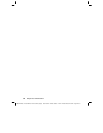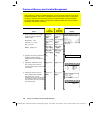
Chapter 20: Number Bases 347
20NUMBAS.DOC TI-89/TI-92 Plus: Number Bases (English) Susan Gullord Revised: 02/23/01 1:17 PM Printed: 02/23/01 2:19 PM Page 347 of 6
Operator with syntax Description
not
integer
Returns the one’s complement, where
each bit is flipped.
·
integer
Returns the two’s complement, which is
the one’s complement + 1.
integer1
and
integer2
In a bit-by-bit
and
comparison, the result
is 1 if both bits are 1; otherwise, the result
is 0. The returned value represents the bit
results.
integer1
or
integer2
In a bit-by-bit
or
comparison, the result is
1 if either bit is 1; the result is 0 only if
both bits are 0. The returned value
represents the bit results.
integer1
xor
integer2
In a bit-by-bit
xor
comparison, the result
is 1 if either bit (but not both) is 1; the
result is 0 if both bits are 0 or both bits
are 1. The returned value represents the
bit results.
Suppose you enter:
0h7AC36
and
0h3D5F
Internally, the hexadecimal
integers are converted to a
signed, 32-bit binary number.
Then corresponding bits are
compared.
If Base mode = HEX:
If Base mode = BIN:
0h7AC36 = 0b00000000000001111010110000110110
and and
0h3D5F = 0b00000000000000000011110101011111
0b00000000000000000010110000010110 = 0h2C16
The result is displayed according to the
Base
mode.
Comparing or Manipulating Bits
The following operators and functions let you compare or
manipulate bits in a binary number. You can enter an integer in
any number base. Your entries are converted to binary
automatically for the bitwise operation, and results are
displayed according to the Base mode.
Boolean Operations
Note: You can select these
operators from the
MATH
/Base
menu. For an
example using each
operator, refer to
Appendix A in this book.
Note: If you enter an integer
that is too large to be stored
in a signed, 32-bit binary
form, a symmetric modulo
operation brings the value
into the range (page 346).
Leading zeros are not shown
in the result.


















